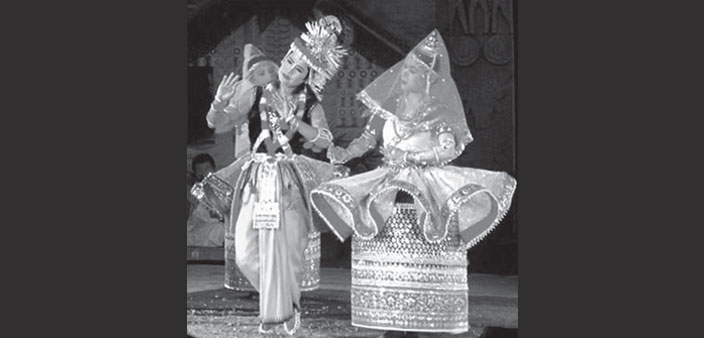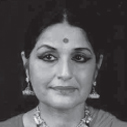The raas leela is a devotional dance-drama that is a distinctive product of the Braj region, a 90 square mile area of Uttar Pradesh province which borders Rajasthan, about 90 miles south of Delhi. It is the special preserve of the people of Braj, for it is devoted entirely to the exaltation of the love of Krishna and Radha, and the earthly exploits of Krishna. Krishna is himself a child of Braj. He was born in Mathura, and Vrindavan, seven miles away, a city sanctified by its association with him. The pilgrims who come here walk barefoot over the very ground that he is reputed to have trod. Each place is invested with a holy meaning because of its connection to Krishna’s earthly existence; Mathura, where he was born in prison; Govardhan, where he lifted the mountain; Gokul, where he spent his childhood and youth; and the banks of the Jamuna river, where he danced with the gopis.
It should be clear by now that the raas leela is a dance-drama that falls in the realm of the sacred. Its home is within the temple walls, close to the holy shrine itself. It is for the eyes and hearts of bhaktas (devotees) and its purpose is to make real the living god, to induce a darshan, an epiphany or vision of Krishna and Radha in all their beauty. It is a lyrical theatre depending heavily on poetry, song, and dance to convey its message.
The raas leela performance
A performance falls into two parts. The first part is called the raasa and it expresses the lovemaking of Radha and Krishna. Krishna who is dark, beautiful, and playful is especially attractive to women, and the beauteous Radha is his choice among them all. From a religious point of view she is the feminine aspect of the godhead, Krishna’s shakti.
The first part of the drama, however tells us of this relationship in terms of earthly, erotic love. From the opening curtain, revealing Krishna and Radha in intimate embrace, through Krishna’s invitation to Radha to dance, through a series of dances and songs, the fine poetry of the bhakti poets and the music of the raas leela troupe members combine in a form that is evocative, emotional, and artistic.
After an interval, the raasa is followed by the leela. This second part always deals with some incident out of the early life of Krishna, such as stealing butter, holding up the milkmaids and demanding a toll payment, going to Radha in disguise, or leaving Gokul for Mathura. In the leela section there is usually less dancing and more song and dialogue.
This theatre, whose dance is now generally acknowledged as the forerunner of the classical kathak dance of North India, began in its present form about the start of the sixteenth century. The tide of bhakti (devotion) that had begun in the south was sweeping over northern India. It was the period of the great Moghuls and, experiencing some religious and political repression, Hinduism turned inward. Fervent devotion to Krishna was the common factor which drew together all those instrumental in creating the theatrical raas leela.
It is significant that contemporary raas leela performers refer back to the example of the milkmaid in the Bhagavata Purana account of the raasa. After dancing with the milk maids in the moonlight Krishna suddenly disappears. They search among the trees for him but cannot find him. To console themselves they remember him by miming or acting out the things which Krishna did when he was among them. They mimic his walk and flute playing; they act out his miraculous feats. Seeing the intensity of their devotion, Krishna returns to them. In the same way today, those who perform and see the imitation of his leela will be blessed with the darshana (vision) of the Lord himself.
Training for raas leela
The performance of raas leela involves skills passed on from father to son or teacher to disciple. Usually the performers are relatives of the teacher or children of friends. The leader of each raas leela troupe is responsible for the training of his performers.
The raasa troupe, headed by a swami, is made up of 10 to 18 persons, all male. Of these, six or eight are boys who play the roles of Krishna, Radha, and Radha’s milkmaid companions. They range in age from about eight to thirteen. In the nitya raasa only these boys appear, but in the leela which follows, adult actors also appear in roles such as Yashoda, Krishna, Shiva, Uddhav, and so on, according to the particular leela being shown. The remainder of the troupe is made up of singers and instrumentalists.
The overall spirit of the leela of Krishna is one of brightness and joyfulness; there is no tragedy or even grave anxiety, for Krishna is the divine enjoyer and his devotees find joy in contemplating that enjoyment. Krishna is the Beautiful God and his epithet, the Beautiful Dark One, aligns with the sensuous loveliness of the face and figure of Krishna. His amorous play with Radha and the milkmaids is the epitome of the expression of his being.
The episodes generally performed from Krishna’s life are: His birth, stealing of butter, display of Radha’s pride and jealousy due to Krishna showering attention on other gopis, Krishna’s going away to Mathura, departing from Gokul, Krishna sending Uddhav to Gokul to pacify the grieving gopis due to Krishna’s departure and Uddhav who is an ‘advaitin’ getting converted to the bhakti cult. Generally the performance ends with the Maha raas leela, which is a special reenactment of his dance with the gopis on the banks of river Jamuna under the full autumnal moon – the sharad purnima.


